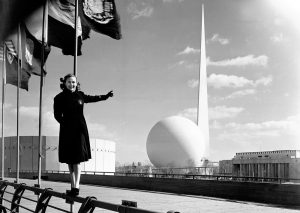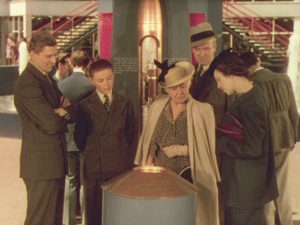

Director, Robert R. Snody, published a film called The Middleton Family at the New York World’s Fair. The 1939 film starts off with the Middleton family traveling to New York City to visit their daughter for the weekend.
Traveling from a rural town in Indiana, the eldest daughter, Babs, planned for her and the family to visit the New York World Fair. An old boyfriend of Bab worked at the fair and was able to give the Middleton family a guided tour. Bab’s current boyfriend, Nicholas, is an art teacher at her university. Although reluctant, Nicholas joins the them for the tour. Nicholas constantly challenged Jim with skeptical questions about the machinery and tried to convince Bab to elope with him. However, Jim answered Nicholas’s questions with confidence on how each item is benefiting society. In terms of him and Bab, a two-dollar wedding ring the grandma discovered revealed not only Nicholas’s low finances but also his low interest of marrying Bab. The film concluded with Bab and Jim reconnecting. Bab asked, “I wonder if the future will be as bright as this”. Jim confidently responded, “This is only a glimpse of what the world will look like in the future”, concluding the film.
A few of the items showcased were machines such as a washing machine, a television set, a microphone, and a three-way lamp. The mother and grandmother were impressed the washing machine and the lamp as it modernized the average home. Whereas, the father and son were impressed by the television set and an electric manipulator used by oil companies.
The film is based on the historical 1939-1940 New York World’s Fair. The event was held at the Museum of the City of New York and was funded by the National Endowment for the Humanities and the New York State Council of the Arts. The purpose was to encourage and excite Americans, especially after the Great Depression. Therefore, “the Fair’s planners, perceiving a collective desire to overcome memories of the Great War and the Great Depression, spend lavish amounts of funds on the construction of the utopian structures [of the fair]. [1]
However, Westinghouse Electric Corporation was the one who spent lavish amounts of money to create the New York World’s Fair. The partnered relationship between the director and Westinghouse portrayed bias throughout the film. For example, the film’s fair took place at the Westinghouse Building in New York City instead. Another example was the concentration on only electric products at the Fair. The Fair had a wide range of manufacturers such as aviation, marine transportation, railroads, communication, business, and production.[2] This ultimately brought awareness to the Westinghouse Corporation and electricity as the new trend in America.
Focusing on Nicholas, he represented the small, but rising, population of anti-capitalists at the time. The “hippie” art teacher represented those individuals who, after the Great Depression, did not trust competitive markets where the financially weak could not survive. He was the 1920s bohemian radical who, “was an irresponsible ‘vagbond’ with only ‘narcissistic’ interests in art and sex while the new intellectual accepted his responsibilities to effect change”[3]. Like Nicholas’s character, anti-capitalists advocated against the income inequality, discrimination, and exploitation of the worker during the rise of the corporate world in America.
Whereas, the protagonist, Jim represented the modern capitalist. For example, Nicholas argued that electric machinery decreases labor. However, Jim explained that the demand for more goods will increase demand for labor. Ultimately, capitalists believed in the, “economic growth, the increase of the standard of living, and the democratization of consumption”[4]. That capitalism is a system that benefits the worker and producer by both are providing goods and services for each other.
Therefore, the play on Jim’s and Nicholas’s character represented the undeniable tension that existed within society after the damaging effects of the Great Depression. This film is not only about the success of the Fair but is a representation of how America was starting to become divided by core beliefs such as capitalism and communism.
[1] Duranti, Marco. “Utopia, Nostalgia, and World War at the 1939-40 New York World’s Fair .” Journal of Contemporary History 41 (October 2006).
[2] Kargon, Robery, and Karen Fiss. WHOSE MODERNITY? Utopia and Commerce at the 1939 New York World’s Fair. University of Pittsburgh Press, n.d.
[3] Abbott, Philip. “Titans/Planners, Bohemians/Revolutionaries: Male Empowerment in the 1930s.” Journal of American Studies. Vol. 40, Cambridge University Press, 2006. JSTOR. Pp. 463 – 485.
[4] Abbott, Philip. “Titans/Planners, Bohemians/Revolutionaries: Male Empowerment in the 1930s.” Journal of American Studies. Vol. 40, Cambridge University Press, 2006. JSTOR. Pp. 463 – 485.
